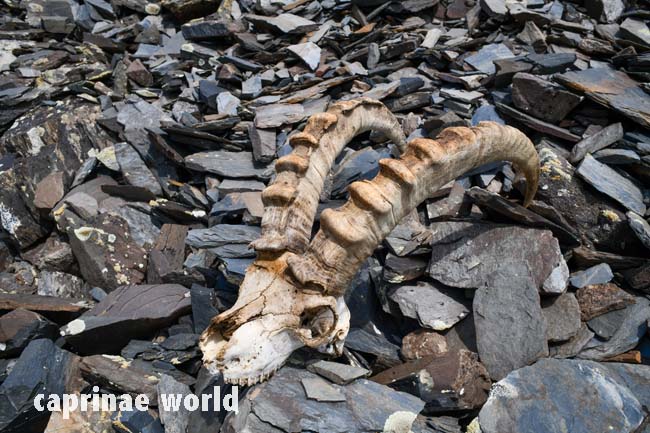Find below a series of photos of magnificent Central Asian Ibex showing physical features, habitat, tracks, sculls, etc.
Distribution
Pamirs and north of the Pamirs; Tian Shan Range and north and east of the Tian Shan. (1, 5)
The Central Asian Ibex and its neighbours: The Central Asian Ibex and the Altai Ibex are seperated only by a small desert gap. In the east there is also only a small gap between the ranges of the Central Asian Ibex and the Gobi Ibex. In the south the Central Asian Ibex-range overlaps with the range of the Himalayan Ibex.
Description
The Central Asian ibex is reportedly the largest of the Asiatic Ibex with the longest horns. Pelage color is mainly dark brown-gray. Winter coat in adult males is relatively dark. They light saddle patch never reaches as far down the flanks as in the Altai Ibex. Also: Dark and light patches have less contrast and extension than in Altai Ibex. In most specimen there is also a lighter area on the back of the neck and a small whitish spot can be seen on the shoulder. Also present: whitish belly, brown front of legs, dorsal stripe. But pelage colourations differ significantly over the wide range of the subspecies. [5]
There is a debate about two separate subspecies of Asiatic Ibex in Tajikistan. One is a so called „White Saddle Ibex“, which is supposed to live in the Eastern Pamirs. The other one is a „Brown Fur Ibex“, which occurs in all other locations of Tajikistan. Biologists have confirmed this morphological diversity in Asiatic Ibex, however no proper research has been conducted so far on that topic.
What is known: 1) Some areas produce only brown Ibex. 2) Some areas produce a lot brown and few white saddle. 3) Some areas produce a lot of white saddle and few brown. 4) During the rut colours get brighter, however those which are brown stay dark brown and in white saddled specimens the saddle becomes more prominent. [Source: Community-based Wildlife Conservation in Tajikistan via facebook, 2020-04-23]

Mature Central Asian ibex (C. s. alaiana) in summer coat. Pelage in this specimen is uniformly brown-grey. Legs are partially black. Saddle patch is not present. Photo: Ralf Bürglin, Kyrgyzstan, Tian Shan, Kyrgyz Ala-Too Range, 2018-08

Mature Central Asian Ibex (C. s. alaiana) in winter coat. Note the diffuse whitish saddle patch, as well as the shoulder patch. Photo: Klaus Rudloff, Moscow Zoo Breeding Station, near Volokolamsk, 2008.

Central Asian ibex (C. s. alaiana) with sweeping horns. Photo: Ralf Bürglin, Kyrgyzstan, Tian Shan, Kyrgyz Ala-Too Range, 2018-08
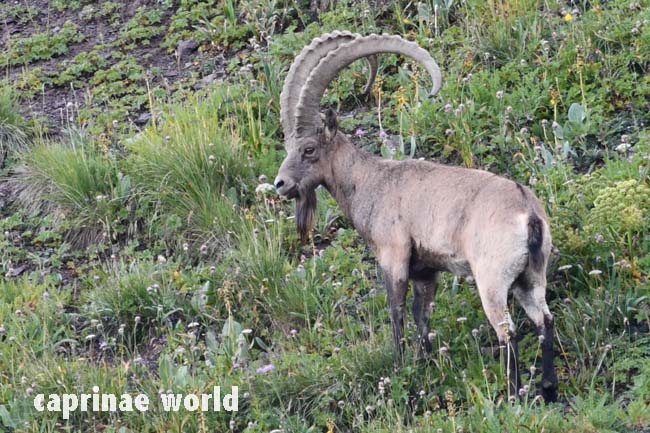
Central Asian Ibex (C. s. alaiana). The long beard is typical for all Asian Ibexes. Photo: Ralf Bürglin, Kyrgyzstan, Tian Shan, Kyrgyz Ala-Too Range, 2018-08

Central Asian Ibex (C. s. alaiana). Note the black metatarsals and black tail. Photo: Ralf Bürglin, Kyrgyzstan, Tian Shan, Kyrgyz Ala-Too Range, 2018-08

Central Asian Ibex (C. s. alaiana) in its habitat. Photo: Ralf Bürglin, Kyrgyzstan, Tian Shan, Kyrgyz Ala-Too Range, 2018-08

Central Asian Ibex (C. s. alaiana) infront of presumed wild rhubarb. Photo: Ralf Bürglin, Kyrgyzstan, Tian Shan, Kyrgyz Ala-Too Range, 2018-08

Horn of a young male Central Asian Ibex (presumably 4,5 years old). Ring diameter: 2 cm. Photo: Ralf Bürglin, Kyrgyzstan, Tian Shan, Kyrgyz Ala-Too Range, 2018-08

Droppings of young Central Asian Ibex. Ring diameter: 2 cm. Photo: Ralf Bürglin, Kyrgyzstan, Tian Shan, Kyrgyz Ala-Too Range, 2018-08
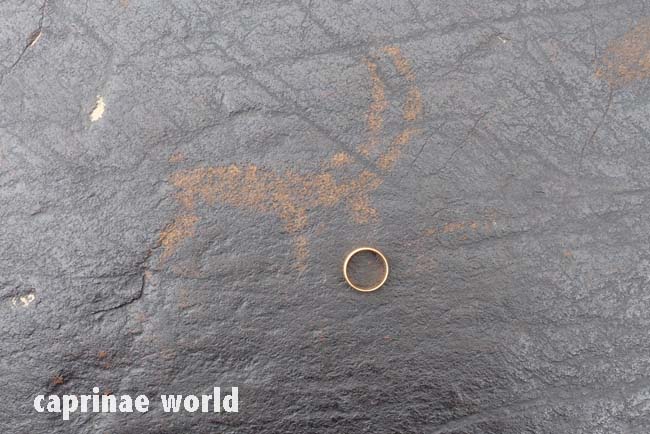
Ibex petroglyph. Ring diameter: 2 cm. Photo: Ralf Bürglin, Kyrgyzstan, Tian Shan, Kyrgyz Ala-Too Range, 2018-08

Ibex petroglyph. Ring diameter: 2 cm. Photo: Ralf Bürglin, Kyrgyzstan, Tian Shan, Kyrgyz Ala-Too Range, 2018-08
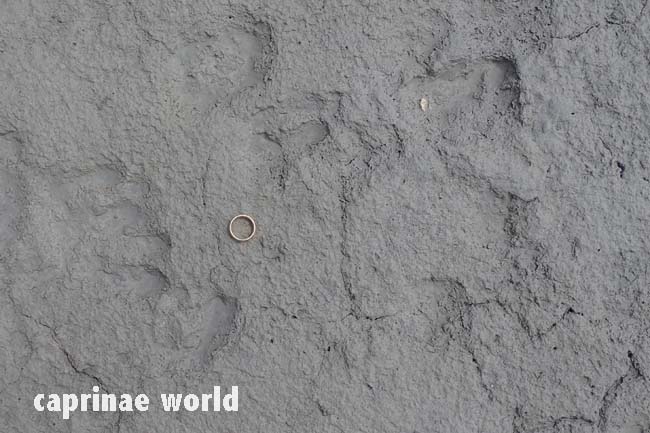
Older and fresher tracks of Central Asian Ibex. Ring diameter: 2 cm. Photo: Ralf Bürglin, Kyrgyzstan, Tian Shan, Kyrgyz Ala-Too Range, 2018-08
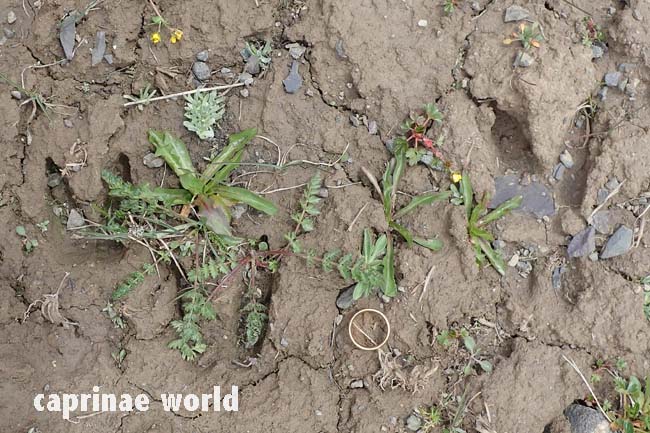
Old – overgrown – tracks of Central Asian Ibex. Ring diameter: 2 cm. Photo: Ralf Bürglin, Kyrgyzstan, Tian Shan, Kyrgyz Ala-Too Range, 2018-08
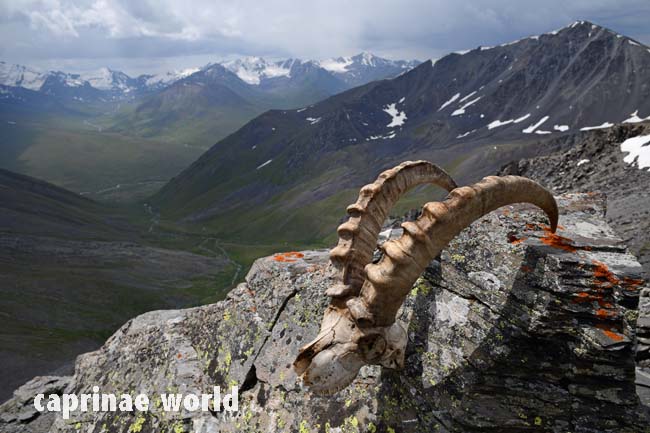
Scull of a male Central Asian Ibex. Photo: Ralf Bürglin, Kyrgyzstan, Tian Shan, Kyrgyz Ala-Too Range, 2018-08
Literature Cited
[1] Reading, R. & Shank, C., 2008. Capra sibirica. The IUCN Red List of Threatened Species 2008: e.T42398A10695735. http://dx.doi.org/10.2305/IUCN.UK.2008.RLTS.T42398A10695735.en. Downloaded on 25 April 2016.
[5] Damm, Gerhard R. and Franco, Nicolás, 2014: The CIC Caprinae Atlas of the World – CIC International Council for Game and Wildlife Conservation, Budakeszi, Hungary in cooperation with Rowland Ward Publications RSA (Pty) Ltd., Johannesburg, South Africa.




